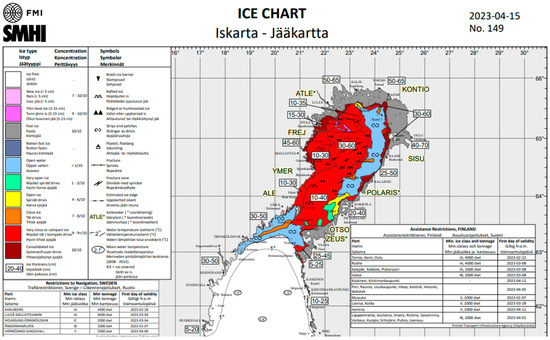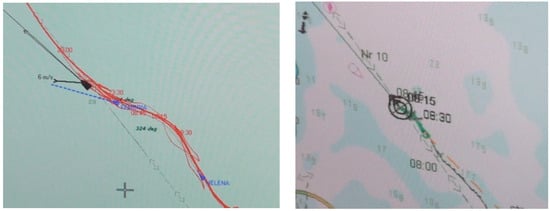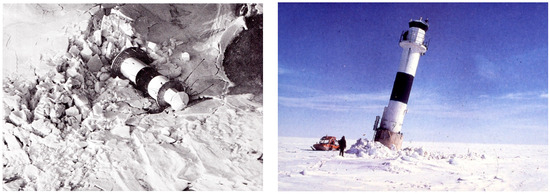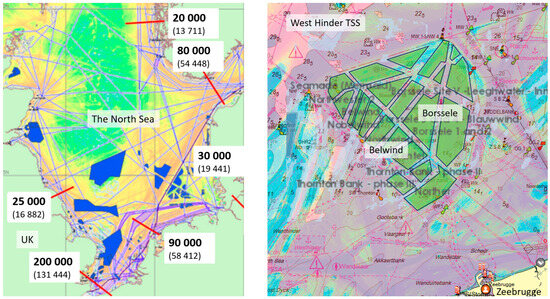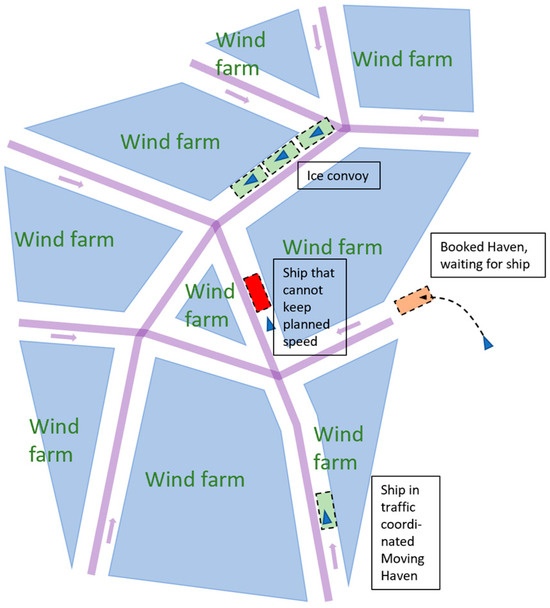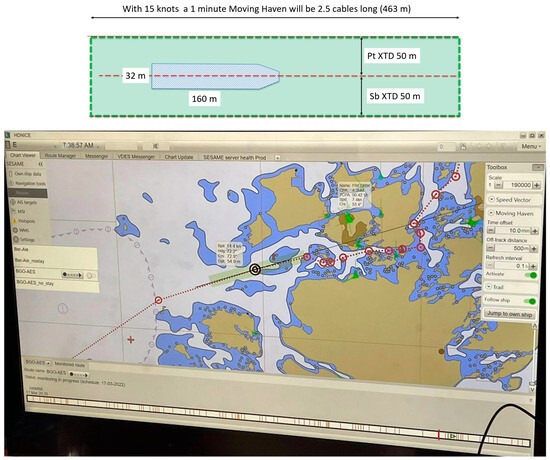Abstract
New areas for the production of fossil-free renewable offshore energy production are planned in Arctic waters in the Bay of Bothnia, in the very north of the Baltic Sea between Sweden and Finland. These are waters normally covered with 30–60 cm of ice every winter and shipping is carried out with icebreaker assistance. This article suggests the need for research on the wind turbine’s effect on ice behavior and ice navigation. Some concepts from previous research are suggested as a solution.
1. Introduction
The global climate situation and UN’s zero emission goal for 2050 is, in Sweden, like elsewhere, leading to an increased pressure for new fossil-free energy production. Public resistance to wind turbines on land has increased interest in offshore wind farms. In the north of Sweden, the steel industry is today using large quantities of coal, but new fossil-free methods will use clean, electro-generated hydrogen. Future demand for electric power will by far overrun the present capacity. So, there is a huge pressure for new, close-range, offshore wind production, and several new wind farms are proposed for the Bay of Bothnia, which is located furthest north in the Baltic Sea (see Figure 1).
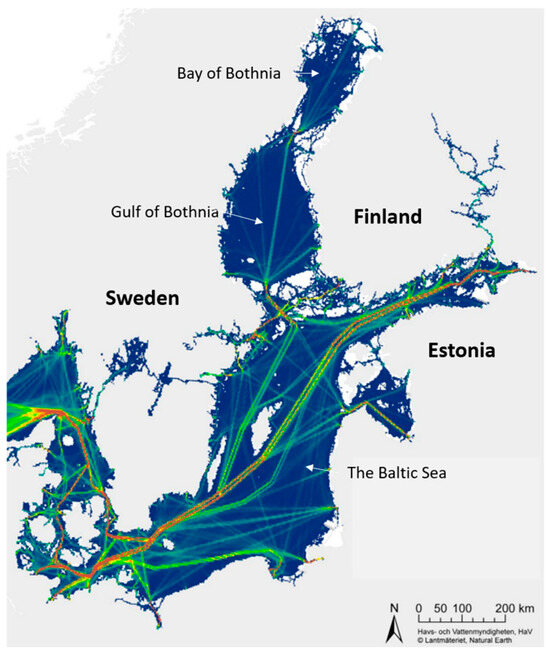
Figure 1.
Map of the Nordic countries with the Baltic Sea, Gulf of Bothnia, and the Bay of Bothnia. Color-graded traffic density from shows the relative traffic flow. Reprinted with permission from Ref. [1]. 2018, The Swedish Agency for Marine and Water Management.
In December 2022, the Swedish Maritime Administration (SMA) expressed concerns regarding plans for offshore wind turbine parks in the Bay of Bothnia. Presently, the SMA is handling over 60 applications for new offshore wind parks around the Swedish coast, but the ones in the Bay of Bothnia are special in the sense that these waters are covered with ice most winters [2]. Sweden and Finland are sustaining the world’s second largest icebreaker fleet to keep the Arctic ports in the area open all year around. As can be seen by the ship traffic density map in Figure 1, the traffic to the Bay of Bothnia is relatively limited in relation to traffic in the Baltic Sea. The number of vessels assisted by icebreakers in the Bay of Bothnia in the winter season 2020–2021 was 1095 ships, with 141 days of restricted traffic [3].
The SMA points to a need to avoid letting wind farms become choke points blocking areas vital to cargo transportation [2]. The direct tracks used during the summer season cannot always be used in the winter. When the sea is covered with ice, the routes must change to accommodate the ice situation. “Icebreaking is mostly about avoiding thick ice and if it is a severe winter the icebreaker must take the possible route. The ice is not static but dynamic and moves depending on meteorological circumstances,” Johan Wahlstöm, at the SMA, says [4]. Figure 2 shows the northern part of the Bay of Bothnia with the big steel port Luleå at the top left in both maps. The left-hand map shows the summer tracks used as well as plans for new wind farms merged from Swedish and Finnish sources [2,5]. The right-hand map overlays the tracks of icebreakers during the 2022–2023 season [2]. As can be seen, the tracks of icebreaker-assisted operations do not correspond to the open water ship traffic patterns in the left-hand map. It is an open question how wind farms will affect the icebreaker-assisted winter shipping in the Bay of Bothnia. Experience and research are lacking.
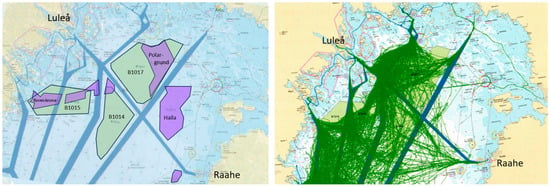
Figure 2.
To the (left) are the ordered tracks of summer shipping in blue. Overlayed are suggested wind parks in green from [2] and in purple from [5]. To the (right) are the green tracks from Swedish icebreakers during the winter season 2022–2023. Adapted with permission from Ref. [2]. 2023, The Swedish Maritime Administration.
5. Discussion
What will the future look like and how can we prepare for it? These are questions that research is constantly trying to answer. We have half a century of experience with navigating in ice with icebreakers, but how wind farms with fixed foundations will influence ice behavior and ice navigation we have next to no knowledge of. We know for certain that climate change will come, and with it a huge need for fossil-free renewable energy production. Maybe ice in the Bay of Bothnia will not be a problem in the future? We do not know. But we know that extreme weather will come more often. Research must in any case continue to gather knowledge, identify potential problems, and suggest solutions.
Traffic coordination using slot-thinking where the bridge officer is reduced to an actuator whose job is to keep the ship in a box on a screen will be annoying to many. But, tomorrow, some ships might sail automatically, and then it will be highly interesting to be able to exactly predict their future movements.
6. Conclusions
This paper has presented new research needs for icebreaker-assisted navigation in wind farms in Arctic conditions. The effects of bottom-fixed wind turbines on ice behavior and on icebreaker-assisted shipping needs to be investigated. Problems as well as potential benefits are possible. Earlier e-Navigation research regarding route exchange and Moving Havens are suggested as potential solutions to traffic organization in such wind farm areas.
Funding
This research has been conducted within the LOAS project funded by the Norwegian Research Council (No. 296527), which is hereby gratefully acknowledged.
Institutional Review Board Statement
Not applicable.
Informed Consent Statement
Not applicable.
Data Availability Statement
Data are available in this manuscript.
Conflicts of Interest
The author declares no conflict of interest.
References
- Swedish Agency for Marine and Water Management. Havsplan Bottniska viken: Förslag till samrådshandling. 15 February 2018. Available online: http://styrelsemote.se/PublicTimra/files/Kommunstyrelsen/2018-05-29%200829%20%20KS%202018-05-29/11%20Remissyttrande%20havsplan%20f%C3%B6r%20Bottniska%20viken/11f%20v1.1%20Samr%C3%A5dshandling%20f%C3%B6rslag%20t...ka%20viken.pdf (accessed on 13 May 2023).
- Sjörapporten. Skydda Farlederna när Vindkraften till Havs Växer. Swedish Maritime Administration. 2023. Available online: https://www.sjofartsverket.se/sv/om-oss/sjorapporten/ (accessed on 13 May 2023). (In Swedish).
- Baltic Icebreaking Management. Baltic Sea Icebreaking Report 2020–2021. Available online: https://baltice.org/app/static/pdf/BIM%20Report%202020-2021.pdf (accessed on 15 May 2023).
- Tidningen Näringslivet. Sjöfartsverket: Vindkraft Till Havs Stoppar Kritiska Sjötransporter. 20 December 2022. Available online: https://www.tn.se/naringsliv/24363/sjofartsverket-vindkraft-till-havs-stoppar-kritiska-sjotransporter/ (accessed on 15 May 2023).
- 4C Offshore.com. Global Offshore Map. Available online: https://www.4coffshore.com/ (accessed on 13 May 2023).
- Porathe, T. e-Navigation in Arctic Conditions: Transmitting High Resolution Ice Routes in First-year Ice. In Proceedings of the Scandinavian Maritime Conference 2012, Horten, Norway, 28–29 November 2012; Available online: https://publications.lib.chalmers.se/records/fulltext/local_166919.pdf (accessed on 13 May 2023).
- Swedish Meteorological and Hydrological Institute. Swedish Ice Service. Available online: https://www.smhi.se/en/services/scandinavian-waters/swedish-ice-service-1.8715 (accessed on 13 May 2023).
- Porathe, T.; Lützhöft, M.; Praetorius, G. What is your intention? Communicating routes in electronic nautical charts. Procedia—Soc. Behav. Sci. 2012, 48, 3266–3273. [Google Scholar] [CrossRef]
- Bergmann, M. Route Exchange in IEC 61174 ed 4 and S-421. Available online: http://www.marine-fields.com/wp-content/uploads/2021/08/IEC-61174-ed-4-and-S-421.pdf (accessed on 13 May 2023).
- Vindkraftsnyheter.se. Sjöfarten Behöver Skyddas när Vindkraften Till Havs Byggs ut. Available online: https://www.vindkraftsnyheter.se/20230331/7646/sjofarten-behover-skyddas-nar-vindkraften-till-havs-byggs-ut (accessed on 13 May 2023).
- Buysse, J. Handling Ships in Ice: A Practical Guide to Handling Class 1A and 1AS Ships; Nautical Institute: London, UK, 2007. [Google Scholar]
- Fransson, L.; Bergdah, L. Recommendations for Design of Offshore Foundations Exposed to Ice Loads; Elforsk Rapport 09:55; Elforsk: Stockholm, Sweden, 2009. [Google Scholar]
- Isaksson, A. Konflikter Väntar Till Havs om Vindkraften NSD, Luleå. 2023. Available online: https://nsd.se/nyheter/lulea/artikel/vindkraftsparker-till-havs-problematiska-for-sjofarten/lz3dwv2j (accessed on 13 May 2023).
- Leppäranta, M.; Hakala, M. The structure and strength of first-year ice ridges in the Baltic Sea. Cold Reg. Sci. Technol. 1992, 20, 295–311. [Google Scholar] [CrossRef]
- Tikanmäki, M.; Heinonen, J. Estimating extreme level ice and ridge thickness for offshore wind turbine design: Case study Kriegers Flak. Wind. Energy 2022, 25, 639–659. [Google Scholar] [CrossRef]
- Porathe, T.; de Vries, L.; Prison, J. Ship voyage plan coordination in the MONALISA project: User tests of a prototype ship traffic management system. In Proceedings of the Human Factors and Ergonomics Society Europe Chapter 2013 Annual Conference; de Waard, D., Brookhuis, K., Wiczorek, R., di Nocera, F., Brouwer, R., Barham, P., Weikert, C., Kluge, A., Gerbino, W., Toffetti, A., Eds.; Human Factors and Ergonomics Society: Santa Monica, CA, USA, 2014; ISSN 2333-4959. Available online: http://hfeseurope.org (accessed on 13 May 2023).
- Marine Traffic.com. Available online: https://www.marinetraffic.com (accessed on 13 May 2023).
- Porathe, T. Moving Havens: An application of the e-Navigation service route exchange. In Proceedings of the International Conference on Human Factors Royal Institute of Nautical Architects Human Factors Conference, London, UK, 19–20 February 2020; Available online: https://www.sintef.no/globalassets/project/hfc/documents/2020-moving-havens.pdf (accessed on 15 May 2023).
Disclaimer/Publisher’s Note: The statements, opinions and data contained in all publications are solely those of the individual author(s) and contributor(s) and not of MDPI and/or the editor(s). MDPI and/or the editor(s) disclaim responsibility for any injury to people or property resulting from any ideas, methods, instructions or products referred to in the content. |
© 2023 by the author. Licensee MDPI, Basel, Switzerland. This article is an open access article distributed under the terms and conditions of the Creative Commons Attribution (CC BY) license (https://creativecommons.org/licenses/by/4.0/).

